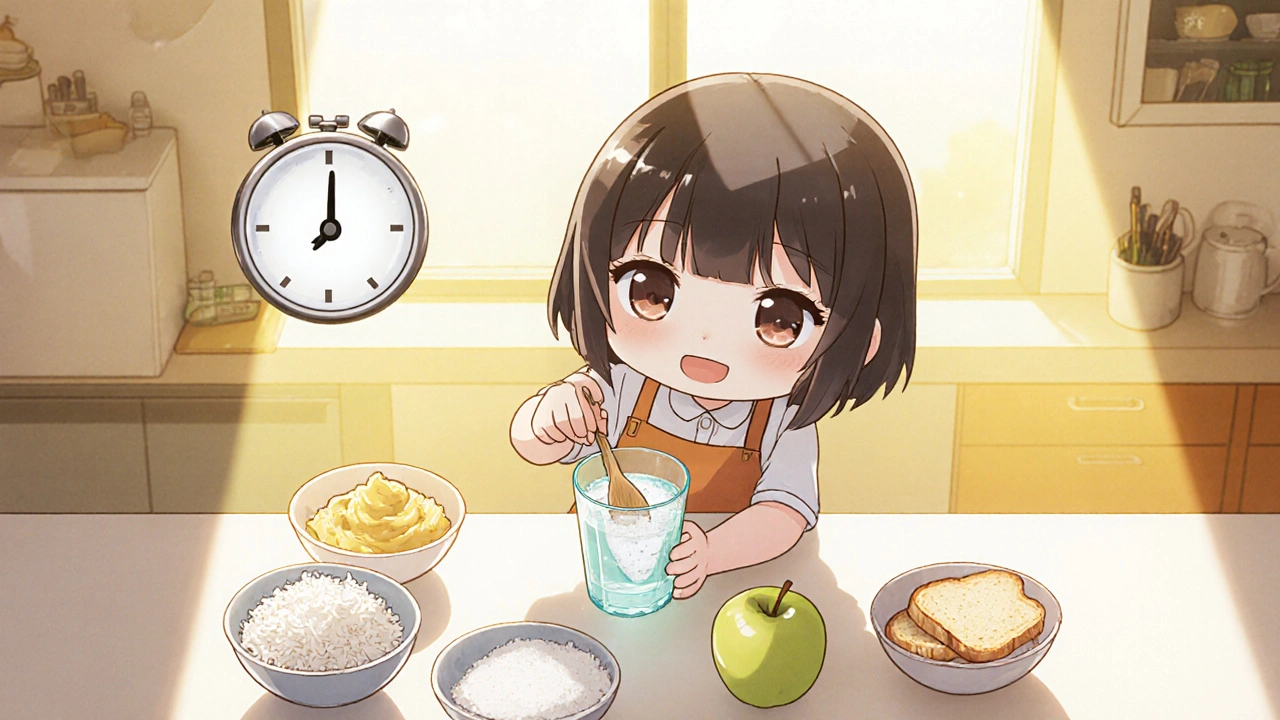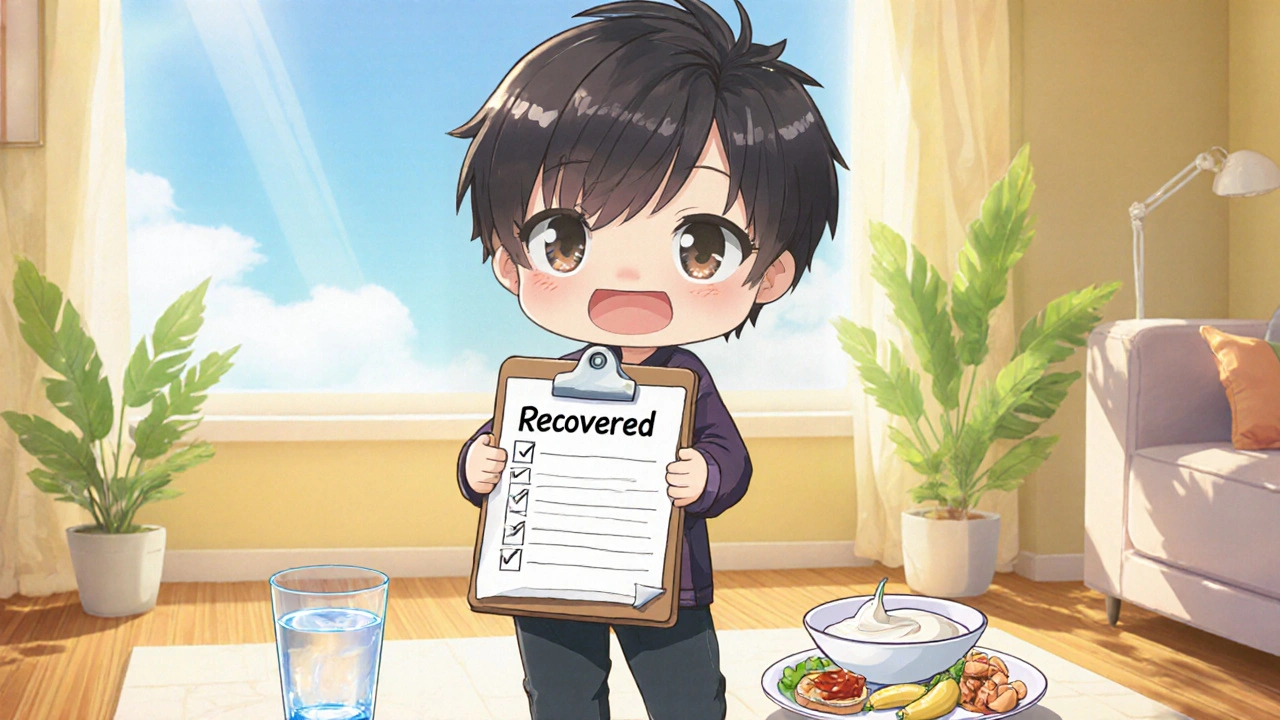Rehydration Solution Calculator
Calculate Your Rehydration Needs
Oral rehydration solution (ORS) is critical for treating diarrhea. Follow CDC guidelines to prepare the proper mixture of water, sugar, and salt.
Your Rehydration Plan
Important: This calculator is for mild to moderate diarrhea. Contact a healthcare professional if you experience severe symptoms like blood in stool, high fever, or signs of dehydration.
Sudden watery stools can strike anyone - a night out, a toddler’s playground, or a long‑haul flight. When the bathroom becomes a frequent stop, the body is losing fluids, electrolytes, and the comfort of a settled gut. One of the oldest, simplest tricks doctors still recommend is a bland, low‑fiber menu called the BRAT diet. Below we break down why it works, how to use it safely, and the extra steps that keep you from slipping into dehydration.
Understanding Acute Diarrhea
Acute diarrhea is defined as the rapid passage of three or more loose stools in a 24‑hour period lasting less than two weeks. The culprit is usually a viral infection (like norovirus), bacterial toxin (food‑borne Salmonella), or a sudden change in diet. In the United States, the CDC estimates about 190 million cases annually, with most people recovering within a few days if they stay hydrated.
The gut lining becomes inflamed, nutrient absorption drops, and water that should stay in the intestines rushes out. That’s why the first goal is to stop the fluid loss and give the digestive system a break from hard‑to‑digest foods.
What the BRAT Diet Actually Is
The acronym stands for Bananas, Rice, Applesauce, and Toast. Each component supplies easy‑to‑digest carbohydrates, a modest amount of potassium, and very little fat or fiber.
Why those four foods? They share three key traits:
- Low in insoluble fiber, which reduces the bulk that can speed up transit.
- Gentle on the stomach lining, limiting further irritation.
- Provide a quick source of energy so the body doesn’t dip into muscle stores while battling the infection.
In clinical practice, the BRAT diet is often paired with oral rehydration solutions to replenish lost electrolytes.
Step‑by‑Step Guide to Using the BRAT Diet
- Start with Oral rehydration solution (ORS) or a homemade mix of 1 liter of clean water, 6 teaspoons of sugar, and ½ teaspoon of salt. Sip ½ cup every 15 minutes for the first hour.
- After the first hour, introduce a small portion (¼ cup) of mashed banana. Wait 30 minutes to see if stools stay solid.
- If tolerance is good, add a spoonful of plain white rice (cooked, no butter). Keep the portion size modest; the goal is a gentle refill, not a full meal.
- Follow with ¼ cup of unsweetened applesauce, then a slice of lightly toasted white bread (no butter, no jam). Repeat the cycle every 2‑3 hours.
- Monitor hydration: clear urine, moist mouth, and less frequent stools indicate progress.
- After 24‑48 hours of steady improvement, slowly re‑introduce low‑fat proteins (boiled chicken, eggs) and cooked vegetables.
Tip: Keep a food diary during recovery. Writing down what you ate and how you felt helps you spot any trigger foods that might be lingering.

Nutrition Snapshot: BRAT Components
| Food | Calories | Potassium (mg) | Fiber (g) | Carbs (g) |
|---|---|---|---|---|
| Banana | 89 | 358 | 2.6 | 23 |
| White rice (cooked) | 130 | 26 | 0.4 | 28 |
| Applesauce (unsweetened) | 68 | 115 | 1.0 | 17 |
| Toast (white bread) | 75 | 115 | 0.8 | 13 |
Notice the low fiber numbers. That’s intentional: less bulk means the colon has a chance to re‑absorb water.
When to Add Electrolytes and Probiotic Support
Rehydration isn’t just water. Electrolytes-sodium, potassium, chloride-keep cells from shrinking and the heart from skipping beats. If a patient is vomiting or has more than four watery stools per day, the CDC advises supplementing the BRAT diet with a sports drink (low‑sugar) or an ORS packet.
After 48 hours, consider introducing Probiotic foods such as plain yogurt or kefir. The live cultures can help restore a healthy Gut microbiome, which often gets knocked out by the infection or any antibiotics you might have taken.
Start with a quarter‑cup of yogurt, watch for any lingering intolerance, then gradually increase.
Common Pitfalls & Myths
- Myth: “Go straight from BRAT to normal meals.”
Reality: Jumping too fast can trigger a relapse. Keep meals bland for another 24‑48 hours. - Myth: “You don’t need fluids if you’re eating.”
Reality: Even bland foods draw water into the gut. Continue sipping ORS until urine is clear. - Myth: “Fruit juice will re‑hydrate.”
Reality: High‑sugar juices can worsen osmotic diarrhea. Stick to water, ORS, or clear broths. - Myth: “Spicy food kills germs.”
Reality: Capsaicin irritates the lining and can lengthen recovery.

When to Seek Professional Care
If any of the following appear, stop the home plan and call a doctor:
- Fever above 101 °F (38.3 °C) lasting more than 48 hours.
- Blood or mucus in the stool.
- Signs of severe dehydration: dizziness, rapid heartbeat, dry skin, or urine that’s dark amber.
- Diarrhea lasting beyond 14 days.
- Infants under 6 months or elderly individuals with chronic illnesses.
In those cases, a clinician may prescribe antibiotics (for bacterial causes), anti‑motility agents, or an IV fluid regimen.
Quick Reference Checklist
- Start with ORS or a homemade salt‑sugar solution.
- Introduce BRAT foods in small, spaced intervals.
- Maintain hydration: aim for at least 1‑2 L of fluid per day.
- Watch for electrolytes: add a sports drink if stools are frequent.
- After 48 hours, add probiotic yogurt and lean protein.
- Stop BRAT and return to a normal diet only when stools are formed for 24 hours.
- Seek medical help for fever, blood, or prolonged symptoms.
Frequently Asked Questions
Can I use the BRAT diet for a child?
Yes. Children as young as 6 months can follow a modified BRAT plan, but substitute mashed banana with pureed banana and use rice cereal instead of regular rice. Always keep an eye on hydration and call a pediatrician if diarrhea lasts more than 24 hours.
Is the BRAT diet suitable for people with diabetes?
Because the diet is high in simple carbs, diabetics should monitor blood sugar closely. Use small portions and pair each serving with a protein source, like a boiled egg, to blunt spikes.
What if I’m lactose intolerant?
Skip the yogurt and probiotic supplements until you’re past the acute phase. Lactose‑free probiotic capsules work well as an alternative.
How long should I stay on the BRAT diet?
Usually 24‑48 hours until stools are solid, then transition to a bland but more varied diet for another day before resuming normal meals.
Can I drink coffee while on the BRAT diet?
Coffee is a diuretic and can further irritate the gut. Stick to water, clear broth, or weak tea until you’re fully recovered.




Wow-this BRAT diet thing really hits the spot!!! I was feeling so drained, and suddenly the banana, rice, applesauce, and toast just swooped in like a superhero squad!!! It’s like the gut finally got a cease‑fire and my stomach said, "Enough!"
Concise tip: sip ORS before you eat.
Hey everyone, love the detailed guide!!! 👍👍 Staying hydrated first and then easing into bananas and rice is the perfect game plan 😊 Keep the positive vibes flowing and you’ll be back on track in no time!
Patriotic health warriors!!! This diet is the true American remedy-simple, effective, and made for the common man!!! No fancy pharma tricks here, just good old‑fashioned food that our ancestors trusted!!!
The BRAT regimen, while seemingly austere, actually taps into a sophisticated physiological response that the body employs during acute gastrointestinal distress. When the intestinal mucosa is inflamed, the absorption of water and electrolytes is compromised, prompting a rapid transit of luminal contents. By providing low‑fiber, easily digestible carbohydrates, bananas, rice, applesauce, and toast minimize the osmotic load that would otherwise exacerbate diarrhea. This reduction in bulk allows the colon more time to reabsorb fluids, thereby decreasing stool frequency. Moreover, the potassium content in bananas and the mild sodium from the toast help replenish electrolytes lost in the stool. The carbohydrate matrix offers a quick source of glucose, which prevents catabolism of muscle protein during the catabolic stress of infection. It is crucial, however, to couple this diet with an oral rehydration solution to address the sodium‑glucose co‑transport mechanism that drives water absorption. While the diet is low in fat and protein, this is intentional to avoid stimulating pancreatic enzyme secretion, which could further irritate the inflamed gut. After the initial 24‑48 hour window, gradual re‑introduction of lean proteins and cooked vegetables supports mucosal healing. Clinical studies have shown that patients adhering to a bland diet recover faster than those who resume a normal diet too quickly, likely due to reduced mucosal irritation. The simplicity of the BRAT diet also makes it accessible worldwide, regardless of socioeconomic status. In pediatric populations, a modified version with rice cereal and pureed bananas offers the same benefits while catering to smaller stomach capacities. Ultimately, the BRAT diet exemplifies a balanced approach: hydrating, nutritionally supportive, and minimally disruptive to the recovering gastrointestinal system.
Consider the BRAT diet as a philosophical pause-a moment where the body, much like the mind, seeks silence before resuming its discourse. It is a brief retreat into simplicity that mirrors ancient practices of fasting for clarity. In that quiet, the gut can mend its walls without the chatter of complex meals.
Yo, have u ever thought that big pharma dont want u to know how easy it is to fix up? They push pills while a banana and some rice can do it for free! Dont trust the meds, trust the basics!!
The step‑by‑step guide is clear and easy to follow, especially the part about sipping oral rehydration solution before introducing any food.
While the article covers the fundamentals well, it overlooks the importance of monitoring blood glucose levels in diabetic patients throughout the BRAT phase. The high glycemic index of bananas and white rice can cause rapid spikes, so a more detailed insulin adjustment schedule would be beneficial. Additionally, the recommendation to avoid all fats may be too restrictive; a modest amount of healthy fats can aid in the absorption of fat‑soluble vitamins that are otherwise limited during this diet. Finally, the checklist could include a reminder to watch for signs of electrolyte imbalance beyond just urine color, such as muscle cramping. Incorporating these nuances would make the guide more comprehensive for a broader audience.
Great addition, thank you for the extra detail. It really helps to have those extra points clarified.
While the article is informative, it fails to address the potential risk of nutrient deficiency if the BRAT diet is extended beyond 48 hours!!! A balanced approach with gradual re‑introduction of proteins and vegetables is essential!!!
Interesting points-though I wonder if the hype around BRAT is a bit overblown 😊 Perhaps a more nuanced view would serve readers better.